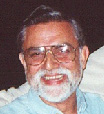Zang tri
Smt. Krishen Kanta Kaw and Dr. Ravi Kaw   That
Zang Tri is
the third day of the New Year (Nowreh). According to mythology, Lord Shiva
created the Universe on Nowreh. On the third day, His Consort (Parvati)
paid a visit to Her parent's home. So, all Kashmiri married women go to
their MALYUN for an hour or two, conveying good wishes for the new year,
and then return to their homes. That is Zang Tri. That
Zang Tri is
the third day of the New Year (Nowreh). According to mythology, Lord Shiva
created the Universe on Nowreh. On the third day, His Consort (Parvati)
paid a visit to Her parent's home. So, all Kashmiri married women go to
their MALYUN for an hour or two, conveying good wishes for the new year,
and then return to their homes. That is Zang Tri.
I would like to add that this story is pregnant
with symbolic meaning. We find similar stories in Bhaagwat Maha-puran,
and even Old Testament: that GOD created the Earth, Sun, and Moon, and
then on the third day.... These seemingly strange (incomprehensible 'mumbo-jumbo'
to some) was explained to me by my teacher as follows:-
That the fundamental event for all conscious
beings is a thought. The first (or the basic) thought of all beings is
the 'I- thought'. This I-thought is also called Ignorance/Maya/Moola-Maya,
etc. It cannot be comprehended, but its properties can be 'seen' mixed
up in everything. The distance between two events gives rise to the concept of
TIME. Time also signifies 'change'. It is this element of time that projects
the concept of SPACE as well. So, using the language of modern Physics,
one can say that TIME/SPACE quantum is the projection of the thought that
follows the 'I thought'. That is why, in English, the fundamental unit
of time is 'second'. It is only after time/space has happened that the
world of plurality can be observed. So, going back, the Supreme Consciousness
(Para-Shiva, Brahman, Yahveh, or whatever name people use) having become
conscious ofitself (through Moola-Maya, Itchha Shakti, or whatever name
one uses, personified as Parvati Devi), sets forth 'creation'.
A short digression on 'CONSCIOUSNESS'When we ask the basic
question 'who am I', prescribed for those with pure 'heart' (or calm disposition),
this Vichaar (thought process)leads to the realization that 'I am that
supreme Brahman', also called by the many other names. Brahman of Vedanta
is nothing but thePara-Shiva of Shaivism, Yahveh of the Jews, etc. It is
this supreme substratum actingthrough the collective mind of all beings
(Maya), that we call GOD or Eshwara.
So, you see a man of realization (Sthita-Pragnya
of Ch-2 Gita) is God walking on two legs. This truth is what sets Hinduism
apart from all the followers of Semitic religions: That we all have the
capability of knowing our true nature, having known which we are ALL capable
of saying 'Aham Brahmosmi' or 'Me and My Father-in Heaven are one'. That
fundamental unity is hidden from us 'at this time' because of our ignorance (avidhya).
The various 'paths' in our religion differ
in only the manner of removing this ignorance, based on the temperament
of the student. The 'amiable one' likes Bhakti, the person-of-action likes
Karma, the intellectual-types like Gyaana, those with none of these likings
like Pranayaama/Hatha-Yoga. When one learns to sever the ties between the
Indriyas (sense organs) and the mind (a stage called Pratihara), all paths
become one. Then on, it is all Guru-Kripa. It is like the space-ship that
has gone against the Gravity, and is now in zero-gravity, light and silent.
So, when a person emerges out of Samadhi
(oneness with one's true being or Shiva), the first thought is I-thought
and the mind is felt in a hushed state. When this mind starts projecting
next thought (because of the unknowable properties of Maya), time/space
is born. And this conscious mind (Parvati), can experience the world of
plurality (Malyun) through the sense organs.
| 